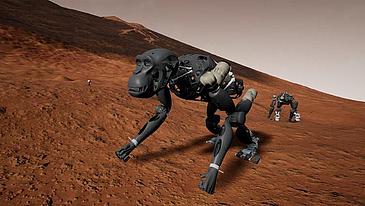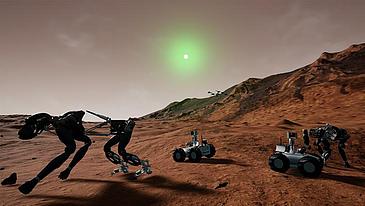The comprehensive exploration of Mars is one of the most important goals of international space travel in the coming decades. In order to avoid endangering people, robots are to take over a variety of tasks. In order to test their use in an alien environment and to realistically simulate the interaction of largely autonomous swarms of robots, scientists from the Technology Centre for Computer Science and Information Technology (TZI) at the University of Bremen, headed by Professor Gabriel Zachmann, have now developed a virtual test environment. Around 40 square kilometres of the canyon system "Valles Marineris" on Mars are now available for the preparation of future missions in virtual reality (VR).
Search for raw materials and extraterrestrial life
Within the framework of the VaMEx-VTB ("Valles Marineris Explorer - Virtual TestBed") project, Professor Zachmann's working group has recreated the "Mariner Valleys" on the basis of NASA scans. "The region was chosen because it is believed to contain raw materials that would be useful for future manned missions and human settlements on the planet," says Professor Zachmann. In addition, there is the possibility of finding evidence of extraterrestrial life, because the conditions for the development of microorganisms could have been good, at least in the past - when Mars was climatically less hostile to life.
Because the terrain in the canyons is very diverse, the exploration also requires robots with different strengths - some can climb, others can fly or transport payloads. In addition, a network of small, radio-based "beacons" must be set up so that the robots can determine their position at any time.
High demands on the software
The TZI software makes it possible to simulate the complex interaction between the robots, taking into account all the planet's special features - such as gravity, soil conditions and extreme temperatures. "To do this, enormous amounts of data first had to be processed to create a realistic, three-dimensional representation of the landscape," says Zachmann. Another challenge was to connect the various robot software systems so that information could be exchanged.
The system has already proven itself in the first tests. The researchers have noticed that robots on Mars need different algorithms than those on Earth in order to determine their position. One reason for this is the very monotonous colours of the terrain, which make it difficult to identify landscape features. It is precisely in such findings that the greatest benefit of the simulation lies: errors can be corrected before the robots one day begin their eight-month journey to Mars. The chance that everything will then work as planned on site increases considerably.
Nationwide cooperation
The VaMEx-VTB project was supported by the German Aerospace Center (DLR) with funds from the Federal Ministry of Economics and Energy (BMWi). The following were involved as contractors of the University of Bremen: the Robotics Innovation Center of the German Research Center for Artificial Intelligence (DFKI GmbH, Bremen), University of the Federal Armed Forces (Munich), TU Munich, TU Braunschweig, DLR Oberpfaffenhofen and the University of Würzburg.
Axel Kölling
Further information:
https://cgvr.informatik.uni-bremen.de/research/vamex-vtb/
www.uni-bremen.de/tzi/
www.uni-bremen.de
Questions to:
Axel Kölling
Public Relations
Technologie-Zentrum Informatik und Informationstechnik (TZI)
Universität Bremen
Tel.: 0171-5305119
E-mail: axelprotect me ?!.koellingprotect me ?!uni-bremen
Universität Bremen
University communication and marketing
Tel.: +49 421 218-60150
E-mail: presseprotect me ?!uni-bremenprotect me ?!.de


